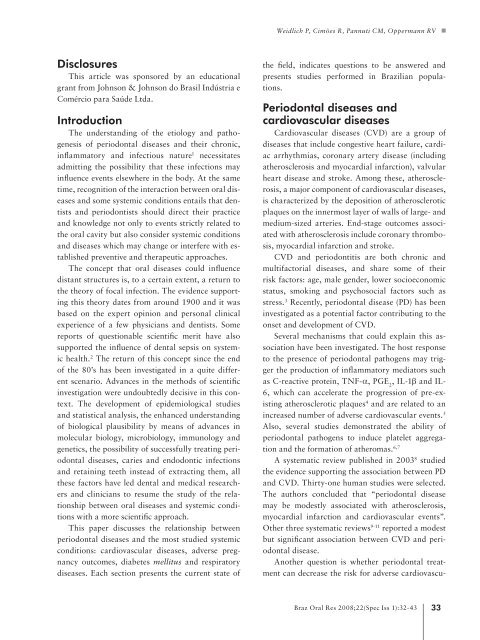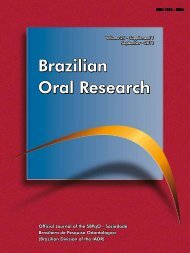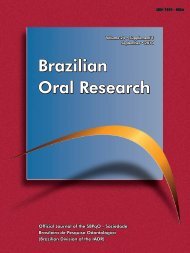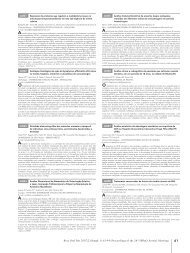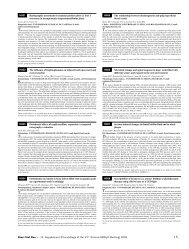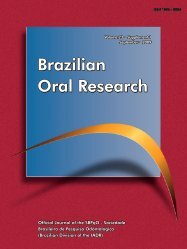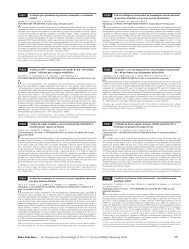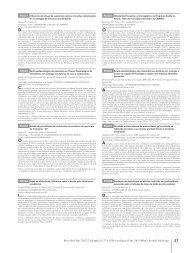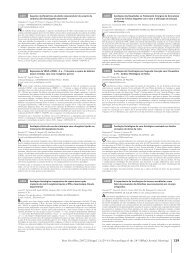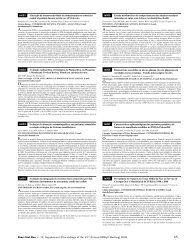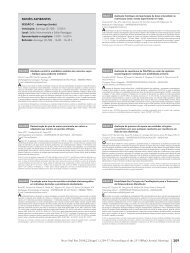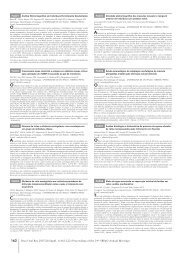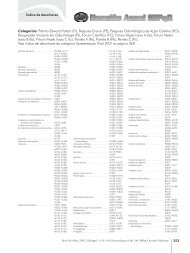Brazilian Oral Research Brazilian Oral Research Brazilian Oral
Brazilian Oral Research Brazilian Oral Research Brazilian Oral
Brazilian Oral Research Brazilian Oral Research Brazilian Oral
Create successful ePaper yourself
Turn your PDF publications into a flip-book with our unique Google optimized e-Paper software.
Disclosures<br />
This article was sponsored by an educational<br />
grant from Johnson & Johnson do Brasil Indústria e<br />
Comércio para Saúde Ltda.<br />
Introduction<br />
The understanding of the etiology and pathogenesis<br />
of periodontal diseases and their chronic,<br />
inflammatory and infectious nature 1 necessitates<br />
admitting the possibility that these infections may<br />
influence events elsewhere in the body. At the same<br />
time, recognition of the interaction between oral diseases<br />
and some systemic conditions entails that dentists<br />
and periodontists should direct their practice<br />
and knowledge not only to events strictly related to<br />
the oral cavity but also consider systemic conditions<br />
and diseases which may change or interfere with established<br />
preventive and therapeutic approaches.<br />
The concept that oral diseases could influence<br />
distant structures is, to a certain extent, a return to<br />
the theory of focal infection. The evidence supporting<br />
this theory dates from around 1900 and it was<br />
based on the expert opinion and personal clinical<br />
experience of a few physicians and dentists. Some<br />
reports of questionable scientific merit have also<br />
supported the influence of dental sepsis on systemic<br />
health. 2 The return of this concept since the end<br />
of the 80’s has been investigated in a quite different<br />
scenario. Advances in the methods of scientific<br />
investigation were undoubtedly decisive in this context.<br />
The development of epidemiological studies<br />
and statistical analysis, the enhanced understanding<br />
of biological plausibility by means of advances in<br />
molecular biology, microbiology, immunology and<br />
genetics, the possibility of successfully treating periodontal<br />
diseases, caries and endodontic infections<br />
and retaining teeth instead of extracting them, all<br />
these factors have led dental and medical researchers<br />
and clinicians to resume the study of the relationship<br />
between oral diseases and systemic conditions<br />
with a more scientific approach.<br />
This paper discusses the relationship between<br />
periodontal diseases and the most studied systemic<br />
conditions: cardiovascular diseases, adverse pregnancy<br />
outcomes, diabetes mellitus and respiratory<br />
diseases. Each section presents the current state of<br />
Weidlich P, Cimões R, Pannuti CM, Oppermann RV<br />
the field, indicates questions to be answered and<br />
presents studies performed in <strong>Brazilian</strong> populations.<br />
Periodontal diseases and<br />
cardiovascular diseases<br />
Cardiovascular diseases (CVD) are a group of<br />
diseases that include congestive heart failure, cardiac<br />
arrhythmias, coronary artery disease (including<br />
atherosclerosis and myocardial infarction), valvular<br />
heart disease and stroke. Among these, atherosclerosis,<br />
a major component of cardiovascular diseases,<br />
is characterized by the deposition of atherosclerotic<br />
plaques on the innermost layer of walls of large- and<br />
medium-sized arteries. End-stage outcomes associated<br />
with atherosclerosis include coronary thrombosis,<br />
myocardial infarction and stroke.<br />
CVD and periodontitis are both chronic and<br />
multifactorial diseases, and share some of their<br />
risk factors: age, male gender, lower socioeconomic<br />
status, smoking and psychosocial factors such as<br />
stress. 3 Recently, periodontal disease (PD) has been<br />
investigated as a potential factor contributing to the<br />
onset and development of CVD.<br />
Several mechanisms that could explain this association<br />
have been investigated. The host response<br />
to the presence of periodontal pathogens may trigger<br />
the production of inflammatory mediators such<br />
as C-reactive protein, TNF-α, PGE 2 , IL-1β and IL-<br />
6, which can accelerate the progression of pre-existing<br />
atherosclerotic plaques 4 and are related to an<br />
increased number of adverse cardiovascular events. 5<br />
Also, several studies demonstrated the ability of<br />
periodontal pathogens to induce platelet aggregation<br />
and the formation of atheromas. 6,7<br />
A systematic review published in 2003 8 studied<br />
the evidence supporting the association between PD<br />
and CVD. Thirty-one human studies were selected.<br />
The authors concluded that “periodontal disease<br />
may be modestly associated with atherosclerosis,<br />
myocardial infarction and cardiovascular events”.<br />
Other three systematic reviews 9-11 reported a modest<br />
but significant association between CVD and periodontal<br />
disease.<br />
Another question is whether periodontal treatment<br />
can decrease the risk for adverse cardiovascu-<br />
Braz <strong>Oral</strong> Res 2008;22(Spec Iss 1):32-43


